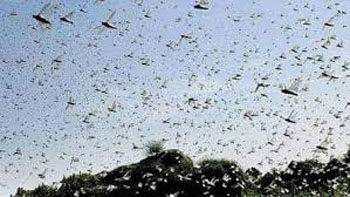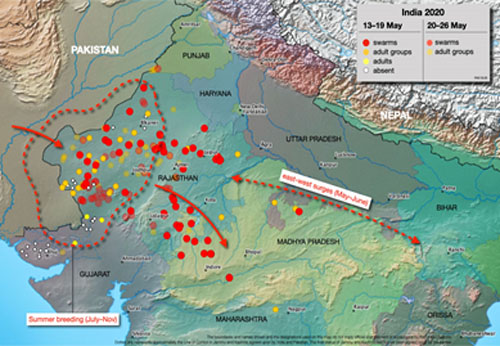|
“The Locust Plague”
Rahul Sinha
COVID-19 and Amphan weren’t enough to shake the economic pillars of India, hence the unexpected intruders came to add up more problems to the list during these difficult times. Already overwhelmed by the Corona Virus, the farmers of India are now concerned about their kharif crops.
The attack of locust swarms has been the latest matter of concern since the past week. These insects are known as desert locusts and are a species of grass hoppers. They are harmless in normal conditions but during the monsoon or due to heavy cyclones they start to reproduce at a much faster rate. Favourable climate in the nations like Yemen, Ethiopia, Kenya, Iran and Afghanistan have helped in the breeding of the locusts. These swarms cover from 50 km’s to more than 100 km’s in a day depending on the wind speed and they feast on each and every bit of greenery on their way. As per the data available with the Union Agriculture Ministry, the locusts damaged crops worth Rs 10 crore during the 1926-31 cycle. India recorded 25 locust plagues and upsurges between 1964 and 1977. In 1993, 190 locust swarms affected at least 3,10,000 hectares in Jaisalmer, Barmer, Bhuj and Jalore districts. This gives us the rudimentary idea of the effect they may have on our economy. The locust swarms will push the Indian economy into fresh trouble during this time of distress.

Image Source - Hindustan Times
Desert locust swarms are now spreading across seven states;
-
Rajasthan
-
Gujrat
-
Punjab
-
Madhya Pradesh
-
Haryana
-
Uttar Pradesh
-
Maharashtra
The containment measures and sprinkling operations have been conducted in 303 locations spread over 47,000 hectares in 20 districts of Rajasthan, 9 districts of Madhya Pradesh, 2 districts in Gujrat and one in each UP and Punjab.
Among various states suffering from this problem, Rajasthan was the first state to use a set of customized drones made by the Union Ministry of Agriculture. These drones were handed over to the Agriculture department and were used to clear big swarm of locusts. The drones were designed to spray 10 litres of chemicals at a time and create a noise to disperse the locusts into different areas. Being the worst affected state, Rajasthan has decided to provide farmers (Insured under the PMFBY scheme) with an advance payment of 25% of their likely claims, as of now this will be implemented in the districts of Barmer, Jaisalmer, Jodhpur, Jalore, Bikaner and Sirohi.
The wind pattern made the scenario worse as the swarm of locusts are now heading towards Delhi. Around 22% of the area covered under Delhi is green and this will have a huge impact due to the locust attack.
Md.Faisal, an entomologist at Yamuna Biodiversity Park is worried about the anticipated impact on the water supply and railway tracks due to the attack, the tracks will become slippery and get clogged while the water will get contaminated.

Image Source - Food and Agriculture organization of US
The above image shows the route and the area covered by the locusts in the month of May, 2020
The World Bank has already approved a $500 million grant at a minimal interest rate to help African and Middle-eastern countries. Where as Pakistan has already declared a national emergency situation due to the outbreak. The plague must be collectively addressed by the Ministry of Agriculture and the Central Government for the interest of the farmers and the agriculturists of India.
Rahul Sinha is a BA Economics (Honours) student of St. Xaviers University, Kolkata.
Back to Home Page
Jun 4, 2020
Rahul Sinha srahul.27501@gmail.com
Your Comment if any
|
